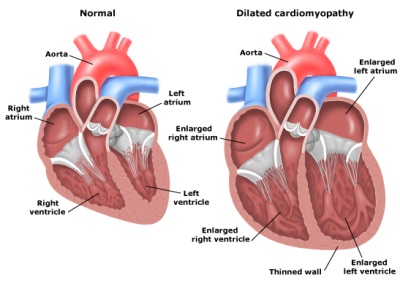Enlarged heart in a child
Heart diseases are very common not only in adults, but also in children of different ages. They can be detected in the newborn, in the nursing baby, in the student, and in the adolescent child. One of the manifestations of such diseases is an enlarged heart, which is also called cardiomegaly.
What is it
An enlarged heart in a child is diagnosed based on a change in its size and shape. At the same time, any one chamber of the heart can increase in a child, and immediately the whole heart. At the same time, its increase can also occur due to the expansion of the chambers, in which the walls remain thin, and due to the thickening of the walls, which is called hypertrophy.
The reasons
The following pathologies can lead to an increase and expansion of the heart in a child:
- Congenital heart disease. An enlarged heart is provoked by such defects as the open arterial duct, Ebstein's anomaly, aortic stenosis, Fallot's tetrad, pulmonary stenosis, septal defect between the atria and others.
- Acquired disease caused by bacterial endocarditis or rheumatism. As a result of inflammation of the inner cardiac membrane, the valves are damaged, which leads to problems in the work of the heart. The disease is manifested by fever, weakness, pathological murmurs and other symptoms.
- Myocarditis. This fairly common disease is an inflammation of the heart muscle caused by viruses, bacteria or other pathogens.
- Cardiomyopathy. This is a genetically caused damage to the heart, in which there may be a thickening of its walls (such cardiomyopathy is called hypertrophic) or expansion of cavities with thinning of the walls (this is a manifestation of dilated cardiomyopathy).
- Heart surgery. In 20-40% of children who have undergone such an intervention, cardiotomy syndrome may develop 2-3 weeks after surgery. Pathology is manifested by severe weakness, fever, chest pain, breathing problems and heart murmurs.
- Oncological process in the heart or development of a benign tumor in the heart tissues.
- Extrahealthy causes for example, sarcoidosis, amyloidosis, hyperthyroidism, lupus, toxoplasmosis, collagenosis, certain medications, fasting.
Symptoms
Clinical manifestations of cardiomegaly are associated with impaired heart function and the disease that provoked an increase in this organ. The most common symptoms in children are symptoms of heart failure. In the early stages, the child does not tolerate physical exertion, he has shortness of breath and weakness, complaints of pain in the heart, increased fatigue. With serious heart disease in which it grows in size, the child will have the following symptoms:
- Palpitations.
- Insufficient mass gain.
- Slowdown in development.
- Pale skin or cyanosis.
- Swelling of the veins of the neck.
- Enlarged liver.
- Edema.
- Frequent lung disease.
- Dyspnea and cough.
- Lowering blood pressure.
- Disturbance of a rhythm of heartbeats.
Diagnostics
The pediatrician may suspect an increase in the children's heart after examining the crumbs, because with it the doctor must evaluate how the rib cage looks, whether it is symmetrical, whether it is not convex or flattened, whether it is enlarged or not changed. Next, the specialist palpates the chest, looking for pulse points and assessing whether they are in characteristic places.In addition, in the diagnosis using percussion and auscultation.
Having identified alarming changes, the baby is directed to:
- X-ray. In most cases, it is on x-rays that the heart is enlarged, because its area of darkening with such pathology becomes larger.
- Echocardiography. This examination will confirm the presence of heart defects that could cause its increase.
- Electrocardiography. The examination will confirm the presence of hypertrophy in the heart.
- Biopsy of the heart tissue. This analysis allows you to see the changes inside the myocardium.
The purpose of all examinations will be to determine the cause of an enlarged heart, and also to exclude conditions that may be “masked” as cardiomegaly, for example, excess fluid in the pericardium or in the pleural cavity.
What to do
If the child has an increase in the size of the heart, you should go with a crumb to a cardiologist and go through the necessary laboratory and instrumental examinations. Only after identifying the cause of cardiomegaly will it be possible to make the correct diagnosis, after which the cardiologist must select a treatment for babies with an enlarged heart.
Depending on the cause of cardiomegaly, antiarrhythmic drugs may be given to the child, antiviral or antimicrobial agents, anti-inflammatory drugs, diuretics, glycosides and other drugs. In some cases, such as congenital defects, surgical treatment is recommended. In case of serious condition one has to resort to organ transplantation.
About what to do with pains in the heart, see the transfer of Dr. Komarovsky.















